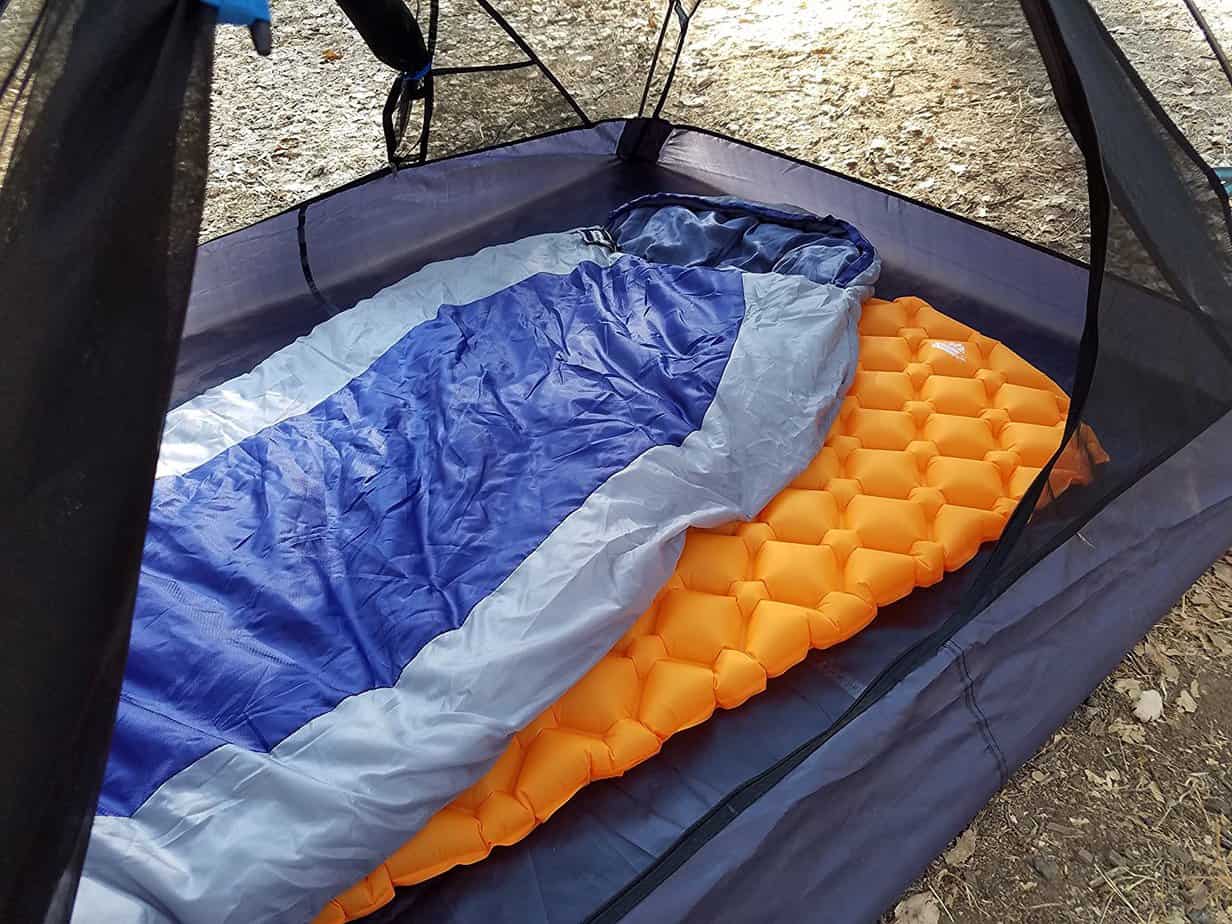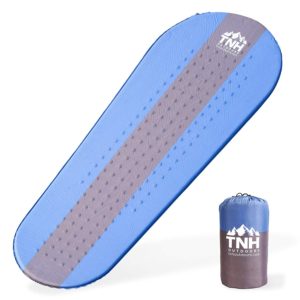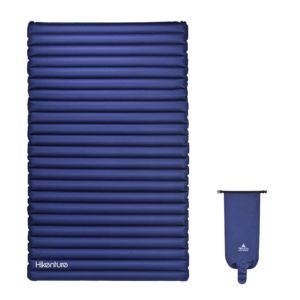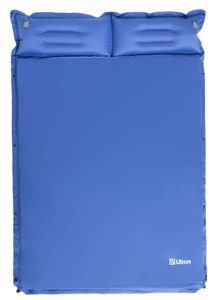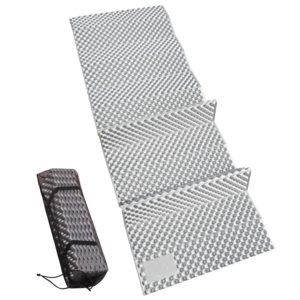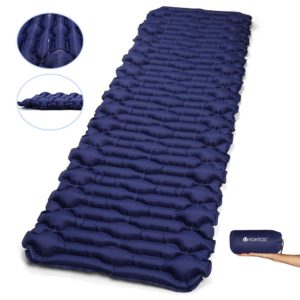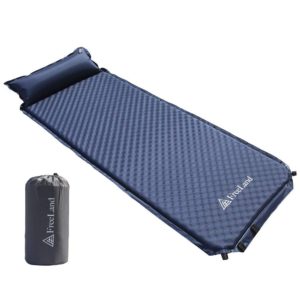When hiking and backpacking it’s important to keep your gear small and lightweight but when your a big guy this can often lead to real challenges and discomfort.
This is never truer than when it comes to sleeping pads and getting a good night’s sleep.
This is why we created this best backpacking sleeping pad for big guys list to help make sure that even if you’re a bigger guy you can still get a good night’s sleep while backpacking and hiking.
Best Backpacking Sleeping Pad for Big Guys
Below is the list of the best sleeping pads we could find for bigger guys or larger backpackers while still providing the portability and versatility a backpacker needs while on the trails.
TNH Outdoors Premium Self Inflating XL Sleeping Pad
One of the best backpacking sleeping pads for big guys is the TNH Outdoors XL sleeping pad. This sleeping pad was truly made with big guys or larger campers in mind. Compared to your average standard backpacking sleeping pad this pad is absolutely gargantuan but still weighs less than 3 pounds and stores in a small storage bag.
Allowing you to get a comfortable nights sleeps on an oversized backpacking sleeping pad but still being compact enough to carry on the trails with you.
Hikenture Double Sleeping Pad
While the Hikenture Double Sleeping Pad was designed to be used by two people, it also makes a great oversized sleeping pad for one person. When this sleeping pad is fully inflated it clocks in at an expansive 79 inches by 47 and a half inches making it large enough for even the biggest of backpackers.
Also, the nice thing about this best backpacking sleeping pad for big guys is its ingenious way the sleeping pad is inflated. Unlike the old days when you would hyperventilate trying to blow up the air mattress, this camping air mattress uses captured airbag technology. Whereby you open the end of the bag attached to this camping pad, trap the air inside, and then force the air into the mattress.
Then when its time to pack up camp the sleeping pad easily deflates, storing in a small tote bag that’s about the size of a loaf of bread.
Ubon Double Self-Inflating Sleeping Pad
While this is another double sleeping pad meant for two people this can also be a great oversized backpacking sleeping pad for one person. If you thought the last sleeping pad was large this one is even bigger with an inflated size of 74.8 inches by 51.2 inches.
Out of all three oversized sleeping pads on this list that we recommend this one is the largest of the three.
As an added bonus this best backpacking sleeping pad for big guys also comes with two built-in pillows to provide additional comfort while camping.
This sleeping pad is also very easy to inflate thanks to its self-inflating design. To inflate this sleeping pad all you have to do is unroll the pad and open the air valves and this pad will inflate itself automatically. As a note, though you do still have to blow up the attached pillows the old fashioned way with your breath.
All of this size and comfort does come at a cost though when it’s time to pack up the campsite and get back on the trails.
Out of all three oversized sleeping pads reviewed when stored this sleeping pad is the largest measuring 24.8 inches by 7.9 inches. So if storage space is a concern then it’s best to steer clear of this oversized backpacking sleeping pad.

How to Choose a Backpacking Sleeping Pad
If you’re looking for a good night’s sleep while enjoying the great outdoors then you definitely need to get a backpacking sleeping pad as they provide cushioning and insulation from the cold hard ground.
But there are literally hundreds of sleeping pads for sale out there, so how are you supposed to know which one is right for you?
By following this quick how-to guide on how to choose a sleeping pad.
Three Main Types of Outdoor Sleeping Pads
The first thing to know is that there are three main types of backpacking sleeping pads on the market which includes the closed-cell foam pad, the inflatable pad, and the self-inflating pad.
Each type of sleeping pad has its own strengths and weaknesses and when choosing a backpacking sleeping pad it’s important to understand these differences to find the right one for you.
Closed-Cell Foam Pad
Closed-cell foam sleeping pads have been the go-to sleeping pads for backpackers and campers for years.
In essence, a closed-cell foam sleeping pad is a pad that uses dense foam that has thousands of little tiny air bubbles in it that provide cushioning from the hard ground as well as a small amount of insulating value.
Closed-cell foam pads are great for backpacking because they are extremely lightweight, super durable, and are typically priced the cheapest out of the three different types of sleeping pads.
However, some of the disadvantages of a closed-cell foam sleeping pad are that they can be bulky and awkward to store and don’t provide a great deal of comfort or padding from the hard ground.
Inflatable Pad
We all have more than likely experienced an inflatable pad at least once in our life as they are just like an air mattress you might find in your home just on a much smaller scale.
An inflatable pad is basically just a nylon shell that is filled with air. The advantages to the inflatable pad when backpacking is that they are extremely compact when stored, some are actually not much bigger than a 1-liter bottle. So when space is a concern the inflatable pad can be a good choice.
Inflatable pads also offer a lot of height and cushioning from the hard ground as once they are inflated some inflatable pads can have a thickness of 2 to 3 inches.
Some disadvantages of the inflatable pad though are they do not typically provide a lot of R-value or insulation from the cold ground, they can be a pain to manually blow up, and they are susceptible to puncture or damage when backpacking and camping.
Self-Inflating Pad
The last type of sleeping pad currently on the market is the self-inflating sleeping pad which is my favorite type of pad.
The self-inflating sleeping pad basically takes the best things from the closed-cell foam pad and the inflatable pad and combines them into one awesome sleeping pad.
The self-inflating sleeping pad uses both air and dense foam to provide both comfort and insulation from the cold hard ground.
In order to inflate a self-inflating sleeping pad all, you have to do is roll the sleeping pad out on the ground, open its air valve, and it will automatically inflate on its own.
It’ not all good news though for the self-inflating sleeping pad as they can sometimes be pretty bulky when stored and just like the inflatable pad they are susceptible to puncture or damage when in the field.
Putting it All Together
So now that you know the three different types of pads that exist on the market and their pros and cons lets take all this information to help you choose the best sleeping pad for your needs and situation.
If you are looking for the cheapest option and don’t need a lot of cushioning the closed-cell foam pad might be the best way to go.
If however, your looking for more comfort and don’t mind adding a little extra weight to your gear then the inflatable sleeping pad or self-inflating pad might be the best choice for you.
The most important thing to remember when choosing a backpacking sleeping pad is to make sure that it fits your body type and sleeping style.
A great video that I found that really sums up all of this information well is below and definitely worth checking out.
How Much Should a Backpacking Sleeping Pad Weigh?
While comfort is important it’s also important to remember that when backpacking whatever you bring with you to set up camp with will ultimately be strapped to your back while you are traversing the trails.
Because of this, it’s important to keep the size and weight down of the sleeping pad you choose.
Typically single camping sleeping pads weigh between just under a pound to as much as 2 or 3 pounds. While this weight range might not seem like that big of a deal when you’re on a 10-mile hike every pound counts.
When looking for a backpacking sleeping pad if you stay around 1 pound you should be in good shape.
What is a Sleeping Pad R-value?
The R-value of a sleeping pad is simply the insulating value the pad offers from the ground you are sleeping on. Sleeping pads typically range from an R-value of 1 up to 6 with the higher the r-value number the better insulation that it offers.
Most backpacking sleeping pads you find on the market today will typically have an R-value of around 2 or 3 which does a pretty good job from insulating you from the cold ground.
Remember though when backpacking there is always a trade-off between bulkiness and weight and the insulation or r-value the sleeping pad offers. As typically the heavier and thicker the sleeping pad is the more r-value or insulation the pad will provide.
So when choosing a backpacking sleeping try to find the most r-value you can find while still keeping the overall weight and bulkiness of the sleeping pad to a minimum.
Do you sleep on your side? Then you should check out our article “Best Sleeping Pad for Side Sleepers While Camping“.

